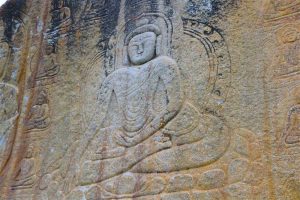
In the previous installment of this column, I described my initial lack of interest in Thích Nhất Hạnh’s teachings and practices. I then recounted the shift in my perception that occurred when I attended his public talk and the innovative blend of traditional and modern elements in his approach to the Dharma profoundly impacted me. I concluded by hinting at the transformative experience I encountered a month later, in June 2007, at the Hua-yen Sūtra performance at the Hong Kong Cultural Centre. In this article, I will continue the story.
The Hua-yen Sūtra, presented and produced by Zuni Icosahedron, was a multimedia theatrical performance based on the original translation by Thích Nhất Hạnh. The performance aimed to immerse the audience in the World of Hua-yen through a captivating blend of chanting, lights, text, images, music, songs, and language. Every emotionally moving scene from the performance remains deeply imprinted in my mind. However, the most unforgettable and profound moment occurred in the few minutes before the performance even began.
I attended the Hua-yen Sūtra on a weekday. After a busy day at work, I went to the performance venue on my own. As I entered the theater, there were fewer than 10 minutes left before the performance began. At that moment, I could only hear the soft murmur of the audience. Once seated, I was immediately captivated by the text projected onto the stage curtain. The delicate tinkling of a wind chime on stage added to the atmosphere.
The text on the curtain consisted of fewer than 10 sentences and appeared in both Chinese and English. First, I saw the Chinese version; I watched each word slowly appear one by one on the left side of the curtain, then disappear one by one after the entire text had been displayed. Next, the English version appeared on the right side of the curtain, with each word following the same pattern of slowly appearing and then disappearing. The two versions alternated in this manner.
The English version was roughly as follows:
Dear friends,
The Hua-yen World is a place of sublime qualities.
Before you enter,
Please temporarily set aside your worries, fears, sorrows, and pains.
Gently focus your attention on your breathing,
Breathing in, smile gently,
Breathing out, relax slowly.
In those final moments before the performance began, I listened to the wind chime and watched the text as it repeatedly appeared, lingered, and vanished. Somehow, tears kept streaming down my face.
Although I had seen similar texts on various occasions before, what I experienced in that moment was quite different. It felt as if a gentle and compassionate voice was speaking directly to me. In the solemn and serene atmosphere, as I followed the guidance to slowly breathe in and out, my worries, fears, sorrows, and pains seemed to gradually melt away.
It was the first time that I truly experienced the transformative power of simplicity. Those simple words had the ability to penetrate deeply into the heart. My mind ceased its constant chatter—no concepts, no analyses—just a profound sense of tranquility and calm.
I experienced a substantial shift in my understanding and connection with Thích Nhất Hạnh’s teachings after attending his public talk (as described in my previous article) and witnessing the Hua-yen Sūtra performance. Shortly after, I obtained the CD recordings from Thích Nhất Hạnh’s recent retreat in Hong Kong, which were freely available to anyone interested. These recordings included teachings and various mindfulness practices offered during the retreat, inspiring me to begin incorporating some of these practices into my daily routine. My favorite practice at the time was “total relaxation,” which helped to release tension in the body to facilitate healing.
I also began reading books by Thích Nhất Hạnh. I would visit the library, find the shelves with his books, and randomly select one to read. Once I finished a book, I would choose another, and then another. Every day after work, I spent time in the library reading his books, and during holidays or days off, I continued reading them at home.
Once I started reading, I found it hard to stop. Thích Nhất Hạnh’s writing, though simple and straightforward, resonated deeply with me. His teachings were not only relevant to daily life but also engaged me on a profound level. They drew me in and compelled me to explore more, leaving me eager to keep reading. Over the next two to three years, I read many of Thích Nhất Hạnh’s books, and my interest in, and understanding of his teachings and practices grew deeper and deeper.
Then, in 2010, I attended a public talk that elevated my understanding of Thích Nhất Hạnh’s teachings to a whole new level. Ven. Thích Chân Pháp Ấn and a group of monastics from Plum Village visited Hong Kong in April of that year to hold a five-day mindfulness retreat. During their stay, Ven. Thích Chân Pháp Ấn also gave public talks, including the one I attended, titled “Peace in Oneself, Peace in the World,” at Hong Kong Polytechnic University. This talk was particularly special because it featured another speaker, Rev. Dr. Thomas Kwan.
During the talk, the two speakers shared their perspectives and experiences on the topic. I never imagined that a Buddhist monk and a Catholic priest would give a talk together, yet they did so in a harmonious and insightful way. What was more, their collaboration highlighted the common ground between their teachings and offered a unique and enriching perspective on interfaith dialogue.
After the talk, there was a short walking meditation outside the lecture theater led by the two speakers. It was a weekday afternoon, so the area was full of people. As the walking meditation began, I saw that Ven. Thích Chân Pháp Ấn and Rev. Dr. Thomas Kwan were holding hands, walking mindfully in front of us, the audience. The image of two men—a Buddhist monk and a Catholic priest—walking hand in hand through a busy university campus was astonishing and moving. It was a powerful and beautiful demonstration of interfaith unity and mutual respect, further amplified by the significance of their shared gesture. I was deeply touched by how the walking meditation embodied the spirit of interfaith dialogue and mutual respect in Thích Nhất Hạnh’s teachings.
Later that year, in November, Thích Nhất Hạnh visited Hong Kong again to lead a five-day mindfulness retreat, Days of Mindfulness, and give public talks. The talk I attended, “Happiness is Here and Now,” was held at the Hong Kong Convention and Exhibition Centre. My seat was in the first row of the wide aisle where the Zen master would walk past as he entered the venue. For a few seconds, I had the opportunity to see him up close. After gaining a deeper understanding of his teachings over the years, I felt a stronger connection upon seeing him in person this time.
At the same time, a two-month-long exhibition titled “Calligraphic Meditation: The Mindful Art of Thích Nhất Hạnh” opened at the University Museum and Art Gallery, University of Hong Kong. The exhibition featured a selection of Thích Nhất Hạnh’s calligraphies created with traditional Chinese ink and rice paper. He introduced a unique style of Zen calligraphy in Chinese, English, Vietnamese, and French, illustrating how calligraphy can serve as a meditative practice. Through single words or simple phrases, he reminded viewers of the essence of mindfulness. I was once again impressed by his creative and skillful approach to presenting Buddhist teachings and practices.
After all these encounters with Thích Nhất Hạnh’s teachings and practices, I felt ready to deepen my practice. In March 2012, I attended a five-day mindfulness retreat at the Asian Institute of Applied Buddhism (Plum Village Hong Kong) on Lantau Island. The experience ignited my desire to visit Plum Village in France. What happened during the retreat? I will share more next time!
Related features from BDG
Formative Encounters with Thích Nhất Hạnh’s Teachings and Practices, Part 1
Formative Encounters with Thích Nhất Hạnh’s Teachings and Practices, Part 3












